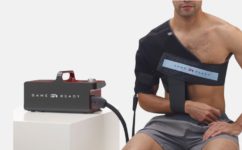Articles
Crippling Knee Pain – What to do?
Crippling Knee Pain – What to do? Susan Locke, M.D., Healthnetwork Medical Director
Knee pain is one of the most common musculoskeletal complaints that bring people to their doctors. Pain can be acute (immediate) or chronic (long term). This article will give an overview of the causes, symptoms and treatment of acute knee pain.
Fractures – Breakage of any of the bones of the knee is typically caused by traumatic injury. Symptoms: Swelling or bruising along with severe pain and tenderness. Evaluation: Knee fractures should be considered as an emergency and should be checked by a doctor. The evaluation will include X-rays and might include an MRI or CT scan. Treatment: Immobilization and possibly surgery to correctly set the bones.
Sprained and torn collateral ligaments – The medial collateral ligament (MCL) is the most common injured ligament. A sprained ligament may be partially ruptured. A torn ligament is completely ruptured. It is usually caused by a force from the outer knee to the inner knee. Symptoms: Tearing or ripping sensation along the inner joint line of the knee. There may be knee instability and swelling. Evaluation: MRI or arthroscopy Treatment: For a mild sprain – compression, ice, elevation, anti-inflammatory medication, pain medicine and exercise program or physical therapy. Complex tears may require surgical repair.
Sprained and torn cruciate ligaments – The anterior cruciate ligament (ACL) injury is a common sports injury caused by a hard stop or violent twisting of the knee. Symptoms: You may hear a pop. The knee gives way or becomes unstable and the pain is severe and is followed by marked knee swelling. Evaluation: physical exam, MRI or arthroscopy Treatment: An option for athletes who need optimal outcomes is surgical repair. More conservative treatment and knee braces may be sufficient for those who are not avid athletes.
Tendon ruptures – Both the quadriceps and patellar tendons may rupture either partially or completely. A quadriceps tendon rupture usually occurs in recreational athletes over age 40. A patellar tendon rupture occurs in younger people who have previous tendonitis or steroid injections in the knee. Symptoms: Rupture of either tendon causes pain. With a complete rupture, you cannot extend the knee. The patella (knee cap) is also often out of place. Evaluation: physical exam, MRI or arthroscopy Treatment: Ruptures generally require surgical repair; although a partial rupture may be treated with splinting alone.
Meniscal (cartilage) injuries – These are typically traumatic injuries, but can also be due to overuse. Symptoms: The knee locks in a particular position or either you hear a click or grind through its range of motion. The knee may give way. Swelling occurs but is usually much less severe than with an ACL injury. Evaluation: physical exam, MRI or arthroscopy Treatment: Often requires surgical repair.
Knee dislocation – This is a rare injury caused by a powerful blow to the knee. The lower leg becomes displaced with relation to the upper leg. This displacement can injure arteries and nerves and thus is an emergency. Symptoms: Severely painful with deformity of the knee. Many will reduce on their own (go back into alignment). Evaluation: physical exam Treatment: If the dislocation does not reduce on its own, the doctor will reduce the dislocation. After reduction, people should be observed in the hospital to ensure no arterial damage or nerve injury has occurred.
Dislocated knee cap (patella) – this is a common injury caused by direct trauma or forceful straightening of the leg. It is more common in women and the obese. Symptoms: The patella (knee cap) is out of place and you may have difficulty flexing or extending your knee. Evaluation: physical exam, X-ray to rule out fracture Treatment: The doctor will reduce the dislocation and usually splint the knee for 3 weeks to allow the soft tissues to heal. Strengthening exercises help keep the patella in line.
While this article focuses on what occurs after you feel knee pain; you can prevent knee injury and pain by following a few simple rules:
1) Keep your weight under control
2) Keep limber and fit. Strengthening and stretching can help prevent knee pain.
3) Exercise wisely and listen to your body. Stop if it hurts.
4) Protect your knees by using knee pads and wearing your seatbelt.


